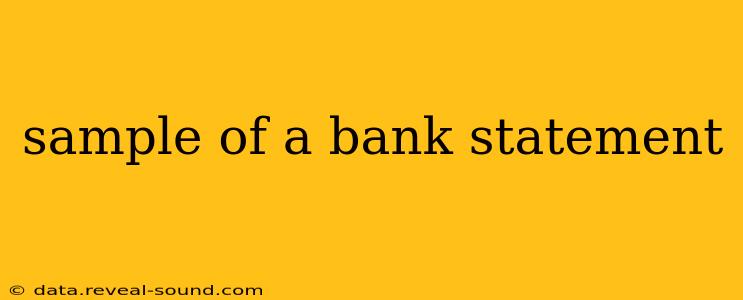A bank statement provides a comprehensive record of your financial transactions within a specific period. Understanding how to read one is crucial for managing your finances effectively. This guide will walk you through a sample bank statement, highlighting key elements and answering common questions.
What Information is Typically Included on a Bank Statement?
A typical bank statement will include the following information:
- Account Holder Information: Your full name and account number.
- Statement Period: The dates covered by the statement (e.g., July 1, 2024 - July 31, 2024).
- Account Balance: Your beginning balance, ending balance, and the total of all transactions during the statement period.
- Transaction Details: A detailed list of every transaction, including the date, description, type (debit or credit), and amount. This section often includes check numbers, ATM transaction locations, and online payment details.
- Fees and Charges: Any fees levied by the bank, such as monthly maintenance fees, overdraft fees, or ATM fees.
- Interest Earned (if applicable): If your account earns interest, this will be shown.
- Contact Information: The bank's contact details for inquiries or support.
What Does a Debit and Credit Mean on a Bank Statement?
-
Debit: A debit reduces your account balance. This reflects transactions where money is withdrawn from your account, such as purchases, ATM withdrawals, checks written, and online payments.
-
Credit: A credit increases your account balance. This reflects transactions where money is added to your account, such as deposits, direct deposits, and interest earned.
How to Interpret a Bank Statement: A Step-by-Step Guide
Let's break down a hypothetical example:
| Date | Description | Debit | Credit | Balance |
|---|---|---|---|---|
| 07/01/2024 | Beginning Balance | $1,000.00 | ||
| 07/05/2024 | Grocery Store Purchase | $50.00 | $950.00 | |
| 07/10/2024 | Payroll Deposit | $2,000.00 | $2,950.00 | |
| 07/15/2024 | ATM Withdrawal | $100.00 | $2,850.00 | |
| 07/20/2024 | Online Payment (Utilities) | $150.00 | $2,700.00 | |
| 07/25/2024 | Interest Earned | $1.50 | $2,701.50 | |
| 07/31/2024 | Ending Balance | $2,701.50 |
In this example, you can clearly see the transactions throughout July, starting with a beginning balance of $1,000.00 and ending with a balance of $2,701.50 after various debits and credits.
What if I have a Discrepancy on My Bank Statement?
If you notice any discrepancies between your records and your bank statement, contact your bank immediately. Compare your check register, receipts, and online transaction records to identify the source of the error. The bank's customer service department can help investigate and resolve any issues.
How Often Do I Receive Bank Statements?
The frequency of bank statements varies depending on the bank and your account type. Most banks issue statements monthly, but some offer options for more frequent or less frequent statements.
By understanding the key components of a bank statement and how to interpret them, you can maintain a clear picture of your financial health and proactively manage your money. Remember, regular review of your bank statements is a crucial part of responsible financial management.
